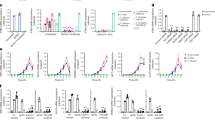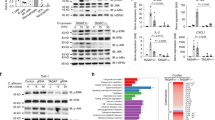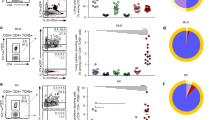Abstract
IL-17-producing CD4+ T helper cells (TH17) have been extensively investigated in mouse models of autoimmunity1. However, the requirements for differentiation and the properties of pathogen-induced human TH17 cells remain poorly defined. Using an approach that combines the in vitro priming of naive T cells with the ex vivo analysis of memory T cells, we describe here two types of human TH17 cells with distinct effector function and differentiation requirements. Candida albicans-specific TH17 cells produced IL-17 and IFN-γ, but no IL-10, whereas Staphylococcus aureus-specific TH17 cells produced IL-17 and could produce IL-10 upon restimulation. IL-6, IL-23 and IL-1β contributed to TH17 differentiation induced by both pathogens, but IL-1β was essential in C. albicans-induced TH17 differentiation to counteract the inhibitory activity of IL-12 and to prime IL-17/IFN-γ double-producing cells. In addition, IL-1β inhibited IL-10 production in differentiating and in memory TH17 cells, whereas blockade of IL-1β in vivo led to increased IL-10 production by memory TH17 cells. We also show that, after restimulation, TH17 cells transiently downregulated IL-17 production through a mechanism that involved IL-2-induced activation of STAT5 and decreased expression of ROR-γt. Taken together these findings demonstrate that by eliciting different cytokines C. albicans and S. aureus prime TH17 cells that produce either IFN-γ or IL-10, and identify IL-1β and IL-2 as pro- and anti-inflammatory regulators of TH17 cells both at priming and in the effector phase.
This is a preview of subscription content, access via your institution
Access options
Subscribe to this journal
Receive 51 print issues and online access
$199.00 per year
only $3.90 per issue
Buy this article
- Purchase on Springer Link
- Instant access to full article PDF
Prices may be subject to local taxes which are calculated during checkout




Similar content being viewed by others
Change history
25 April 2012
A present address was added for C.E.Z.
References
Korn, T., Bettelli, E., Oukka, M. & Kuchroo, V. K. IL-17 and Th17 Cells. Annu. Rev. Immunol. 27, 485–517 (2009)
Romani, L. Immunity to fungal infections. Nature Rev. Immunol. 11, 275–288 (2011)
Milner, J. D. et al. Impaired TH17 cell differentiation in subjects with autosomal dominant hyper-IgE syndrome. Nature 452, 773–776 (2008)
Ma, C. S. et al. Deficiency of Th17 cells in hyper IgE syndrome due to mutations in STAT3 . J. Exp. Med. 205, 1551–1557 (2008)
Puel, A. et al. Chronic mucocutaneous candidiasis in humans with inborn errors of interleukin-17 immunity. Science 332, 65–68 (2011)
Ivanov, I. I. et al. The orphan nuclear receptor RORγt directs the differentiation program of proinflammatory IL-17+ T helper cells. Cell 126, 1121–1133 (2006)
Acosta-Rodriguez, E. V. et al. Surface phenotype and antigenic specificity of human interleukin 17-producing T helper memory cells. Nature Immunol. 8, 639–646 (2007)
Jankovic, D. et al. Conventional T-bet+Foxp3− Th1 cells are the major source of host-protective regulatory IL-10 during intracellular protozoan infection. J. Exp. Med. 204, 273–283 (2007)
Saraiva, M. et al. Interleukin-10 production by Th1 cells requires interleukin-12-induced STAT4 transcription factor and ERK MAP kinase activation by high antigen dose. Immunity 31, 209–219 (2009)
Chung, Y. et al. Critical regulation of early Th17 cell differentiation by interleukin-1 signaling. Immunity 30, 576–587 (2009)
Ghoreschi, K. et al. Generation of pathogenic TH17 cells in the absence of TGF-β signalling. Nature 467, 967–971 (2010)
Stumhofer, J. S. et al. Interleukins 27 and 6 induce STAT3-mediated T cell production of interleukin 10. Nature Immunol. 8, 1363–1371 (2007)
McGeachy, M. J. et al. TGF-β and IL-6 drive the production of IL-17 and IL-10 by T cells and restrain TH-17 cell-mediated pathology. Nature Immunol. 8, 1390–1397 (2007)
Annunziato, F. et al. Phenotypic and functional features of human Th17 cells. J. Exp. Med. 204, 1849–1861 (2007)
Yang, X. P. et al. Opposing regulation of the locus encoding IL-17 through direct, reciprocal actions of STAT3 and STAT5. Nature Immunol. 12, 247–254 (2011)
Acosta-Rodriguez, E. V., Napolitani, G., Lanzavecchia, A. & Sallusto, F. Interleukins 1β and 6 but not transforming growth factor-β are essential for the differentiation of interleukin 17-producing human T helper cells. Nature Immunol. 8, 942–949 (2007)
Wilson, N. J. et al. Development, cytokine profile and function of human interleukin 17-producing helper T cells. Nature Immunol. 8, 950–957 (2007)
Yang, L. et al. IL-21 and TGF-β are required for differentiation of human TH17 cells. Nature 454, 350–352 (2008)
Manel, N., Unutmaz, D. & Littman, D. R. The differentiation of human TH-17 cells requires transforming growth factor-β and induction of the nuclear receptor RORγt. Nature Immunol. 9, 641–649 (2008)
Cosmi, L. et al. Human interleukin 17-producing cells originate from a CD161+CD4+ T cell precursor. J. Exp. Med. 205, 1903–1916 (2008)
Volpe, E. et al. A critical function for transforming growth factor-β, interleukin 23 and proinflammatory cytokines in driving and modulating human TH-17 responses. Nature Immunol. 9, 650–657 (2008)
Napolitani, G., Acosta-Rodriguez, E. V., Lanzavecchia, A. & Sallusto, F. Prostaglandin E2 enhances Th17 responses via modulation of IL-17 and IFN-γ production by memory CD4+ T cells. Eur. J. Immunol. 39, 1301–1312 (2009)
Smeekens, S. P. et al. The Candida Th17 response is dependent on mannan- and β-glucan-induced prostaglandin E2. Int. Immunol. 22, 889–895 (2010)
Laurence, A. et al. Interleukin-2 signaling via STAT5 constrains T helper 17 cell generation. Immunity 26, 371–381 (2007)
Hoyer, K. K., Dooms, H., Barron, L. & Abbas, A. K. Interleukin-2 in the development and control of inflammatory disease. Immunol. Rev. 226, 19–28 (2008)
Gattorno, M. et al. Pattern of interleukin-1β secretion in response to lipopolysaccharide and ATP before and after interleukin-1 blockade in patients with CIAS1 mutations. Arthritis Rheum. 56, 3138–3148 (2007)
Geiger, R., Duhen, T., Lanzavecchia, A. & Sallusto, F. Human naive and memory CD4+ T cell repertoires specific for naturally processed antigens analyzed using libraries of amplified T cells. J. Exp. Med. 206, 1525–1534 (2009)
Messi, M. et al. Memory and flexibility of cytokine gene expression as separable properties of human TH1 and TH2 lymphocytes. Nature Immunol. 4, 78–86 (2003)
Crome, S. Q., Wang, A. Y., Kang, C. Y. & Levings, M. K. The role of retinoic acid-related orphan receptor variant 2 and IL-17 in the development and function of human CD4+ T cells. Eur. J. Immunol. 39, 1480–1493 (2009)
Mayoral, R. J. & Monticelli, S. Stable overexpression of miRNAs in bone marrow-derived murine mast cells using lentiviral expression vectors. Methods Mol. Biol. 667, 205–214 (2010)
Acknowledgements
We thank O. Petrini and C. Fragoso for providing microorganisms, and M. Levings for providing the RORC lentiviral vector. We thank A. Rossetti for technical assistance, D. Baumjohann for artwork and S. Jacob and M. Uguccioni for critical reading of the manuscript. This work was supported by a fellowship of the German Research Foundation (DFG) to C.E.Z (Zi 1262/1-1) and by grants from the Swiss National Science Foundation (N. 131092 to F.S. and 126027 to A.L.) and the Institute of Arthritis Research (IAR). A.L. is supported by the Helmut Horten Foundation.
Author information
Authors and Affiliations
Contributions
C.E.Z. designed and performed experiments, analysed the data and wrote the manuscript, D.J. performed the sorting and analysed data, F.R. performed and analysed experiments in the mouse system, F.M., D.A., and S.M. performed experiments to address the mechanism of IL-17 downregulation and analysed the data, M.G. provided the samples from CAPS patients and analysed the data, A.L. wrote the manuscript, F.S. provided overall supervision, analysed the data and wrote the manuscript.
Corresponding authors
Ethics declarations
Competing interests
The authors declare no competing financial interests.
Supplementary information
Supplementary Figures
This file contains Supplementary Figures 1-10. (PDF 854 kb)
Rights and permissions
About this article
Cite this article
Zielinski, C., Mele, F., Aschenbrenner, D. et al. Pathogen-induced human TH17 cells produce IFN-γ or IL-10 and are regulated by IL-1β. Nature 484, 514–518 (2012). https://doi.org/10.1038/nature10957
Received:
Accepted:
Published:
Issue Date:
DOI: https://doi.org/10.1038/nature10957
This article is cited by
-
Perinatal tissue-derived exosomes ameliorate colitis in mice by regulating the Foxp3 + Treg cells and gut microbiota
Stem Cell Research & Therapy (2023)
-
High levels of endothelial ICAM-1 prohibit natalizumab mediated abrogation of CD4+ T cell arrest on the inflamed BBB under flow in vitro
Journal of Neuroinflammation (2023)
-
The reciprocal interactions between microglia and T cells in Parkinson’s disease: a double-edged sword
Journal of Neuroinflammation (2023)
-
The choroid plexus acts as an immune cell reservoir and brain entry site in experimental autoimmune encephalomyelitis
Fluids and Barriers of the CNS (2023)
-
An IL-17-EGFR-TRAF4 axis contributes to the alleviation of lung inflammation in severe influenza
Communications Biology (2023)
Comments
By submitting a comment you agree to abide by our Terms and Community Guidelines. If you find something abusive or that does not comply with our terms or guidelines please flag it as inappropriate.



